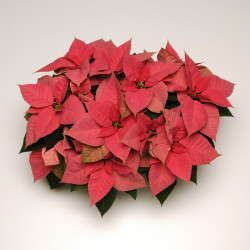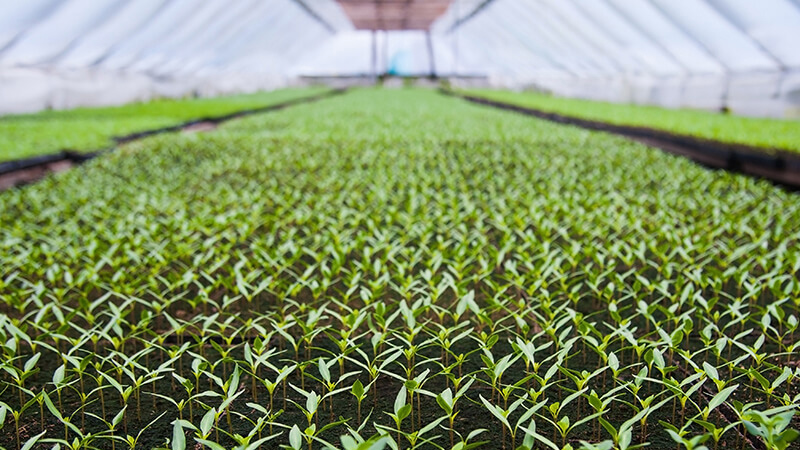The State Of The Poinsettia Market

Every year, Greenhouse Grower asks its readers to reflect on their poinsettia crops, prices and the overall state of the market. Growers of all sizes responded to our survey, and the results are in for the 2012 season. Here is a look at some of the most notable statistics. For the full whitepaper results, visit GreenhouseGrower.com/February2013.
Poinsettia Production Varied From 2011
While the majority of respondents (42.1 percent) increased poinsettia production overall, the percentage of growers that produced the same number or fewer than last year both clocked in at 28.95.
When it came to novelties, however, 44.74 percent of growers produced the same number over the last two years, with 31.58 percent producing more and 26.38 percent growing fewer plants, respectively.
The number of poinsettias in the dumping pile was stable with 64.7 percent dumping zero to less than 5 percent of their poinsettia crop compared to 69 percent in 2010. Another thing that hasn’t changed is the popular sizes, which continue to be 6 and 6.5 inches.
Grower Impressions Of The Market
We asked growers to give their thoughts on how poinsettias sold for them. While some of the comments differed from what the survey revealed, most respondents were pleased with sales.
“The market was good overall. Smaller sizes, miniatures and 4-inch poinsettias seemed to be extra popular this year.”
“Topiaries and shapes are still our biggest market, though the interest in smaller sizes is greater than our long-standing larger sized topiaries.
“Our sales slowed dramatically the second week in December. Selling pinched poinsettias may or may not be a viable market for our area.”
“It once again sucked.”
“The market is as strong as ever, with more interest in certain novelty varieties. Larger pot sizes are moving faster than in past years.”
“After five or six years of declining numbers and too many plants going to dump, it looks like we are finally going to sell out and may actually look at a small increase next year.”
The Poinsettia Market In Pictures
Greenhouse Grower columnist Jerry Montgomery visited 64 box stores in Florida and Michigan. Here’s a photo journal of some of his findings.
“Black Friday has now turned into Filthy Thursday and is getting old and tired, with the industry featuring a $0.99 poinsettia that, in some cases, may not be worth that price. Prices have not changed much since last year, and clearly, creativity has not improved. Where is the innovation?”
“The noticable bright spot was the continuing improvement of product quality and assortment at Walmart. Walmart also had some interesting novelties positioned for their customer base such as Santa’s boots with 8-inch poinsettias that retailed for $12.98. Sam’s Club offered some interesting new items this season, including a 12-inch, square terrarium with ivy and a poinsettia. This item retailed for $22.98.
“There are vast differences in the amount of glue and glitter used amongst retailers. It appears some vendors just don’t understand the amount of glitter it takes to make a compelling look. There is also a vast difference in the appearance of glittered plants depending on the shade of red. The dark reds are not nearly as attractive as the lighter reds.”
The Price Of Premium Poinsettias
Parks Brothers’ Jason Parks explains poinsettia pricing, the plant’s target demographic and his view of the future market.
“I feel the poinsettia market is declining for independent garden centers and shifting to the chain stores. For 2012, I think the poinsettia market was flat or decreased slightly. For 2013, I think it will remain flat, plus or minus 5 percent. I believe the economic and political environment was detrimental to poinsettia sales, and I believe it will continue to affect sales for at least another year.
“The market for premium poinsettias is shrinking fast as the younger members of our target demographic enter the poinsettia market. In my opinion, 90 percent of all end consumers that buy, or even look at, poinsettias do not know what a nice poinsettia is supposed to look like and balk at buying the higher-priced poinsettias in the independent garden centers (and at chain stores, too).
“To them, there is not enough perceived value in a $20 to $30 10-inch poinsettia compared to a decent-looking $3.99 6-inch poinsettia. They can buy five to seven for the same amount of money and get twice the bang for their bucks.
“This is what makes the chain store poinsettias more popular than those at the independent garden centers. Yes, there are a lot of independents selling premium poinsettias and doing OK to very well with this plant. I am glad they are doing it, and I hope they can keep it up. I hope they call me if they need more poinsettias. However, they are never going to match the volume and pricing the chain store command, which is the poinsettia market price baseline. When you add in the chains using them as loss leaders, there is absolutely no way independent garden centers can compete.
“I believe we are near the end of a major transition of the poinsettia market to chain stores. I also believe that this transition will level off in the next few years. The chains will control the majority of the poinsettia market (if they don’t already), and we will see a lot of independents cut back to very few or no poinsettias, while a small percentage will continue with a niche premium poinsettia market they either grow themselves or have contract grown to their specifications.”
Selecta Breeds Its Poinsettias For Grower Convenience
For Gary Vollmer, who has been growing poinsettias for most of his adult life, excellence in breeding is an important part of growing the poinsettia market and keeping it profitable for growers.
Growers are choosing the varieties that provide the higher yields,” says Vollmer, technical support manager for Selecta Poinsettia. “The breeding is going in the directrion of better shelf life. Growers are reducing shrink on the greenhouse floor and at retail, which is a very healthy direction to go.”
Vollmer says Selecta is following breeding trends that began in Europe and are now moving into the U.S.
“[In Europe] they basically shifted the poinsettia market into a little bit smaller product, and the expectations of shelf life and yield are much higher,” he says.
“Another technique that is huge in Europe and is really gaining ground in North America is finding poinsettias that can be grown cool, cutting the heating bill. It’s an outstanding strategy. Some growers have gone into this in a very big way.
“There’s one large grower who produces more than one million poinsettias. They focus all of their red poinsettia production in cool houses, and they’re talking about saving more than a quarter of a million dollars. We’re not going to bring forward anything — especially reds — that will not be very happy at cooler temperatures.”
Vollmer says Selecta’s breeding efforts are focused on what works for the grower. Besides the ability to be grown cool, cultivars that eventually make it to market must have an excellent branching habit (important for shipability) and a long shelf life.
“A lot of varieties we look at don’t get a chance to progress if they don’t do really well at postharvest,” Vollmer says.
‘Christmas Day,’ a medium-vigor, mid-season dark red, has been the backbone of Selecta’s poinsettia crop.
“It works very well in a 6-inch pot and, as we’ve seen in the last two years, in that large Costco pot as well,” Vollmer says. “Another variety coming on really strong for us is ‘Christmas Beauty.’ It’s outstanding in the Midwest and South. In warmer areas it finishes full size, and it’s really beautiful. We have a strong family behind it — a pink and a very interesting novelty called ‘Nostalgia,’ which has a greenish background with a marble pattern. There’s a lot of strong stuff coming out of the Beauty series.”
‘Christmas Joy,’ an early-season, medium-vigor red, is a introduction for 2013. Vollmer says it is well-suited for weeks 46 to 47 in the Thanksgiving time frame. “It has really, really high uniformity, deep branching, great roots and great postharvest — all the things that make a great grower variety,” he says.
‘Christmas Glory is another 2013 introduction and is designed for Black Friday sales. As an early-season, low-vigor red, it’s targeted to high-density 4-, 5.5- or 6-inch production.
New cultivars in trials this year include a series with the working name Candy Store, which features unique, very bright colors.
“We have one that’s almost a hot watermelon pink color — very intense,” Vollmer says. “Another one is a really rich, creamy pink with some freckles on it. It’s a beautiful color, very luxurious. And we even have a lime green. It’s an early season, high-yield variety. I don’t know if it’s strong enough to take off, but I have shown it to some chainstore and grocery buyers. They like the concept of pushing the envelope — especially early in the season. All the Candy Store varieties are excellent grower varieties as well. If it isn’t going to work for the grower and be a good production variety, it’s never going to be part of our program.”










